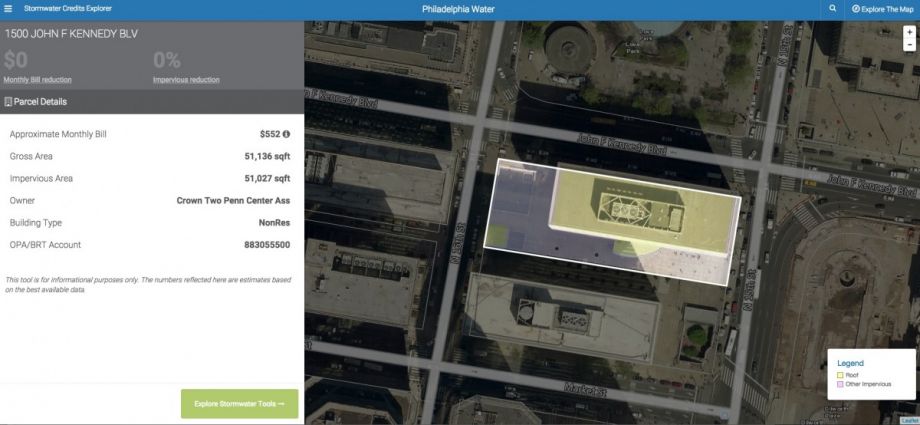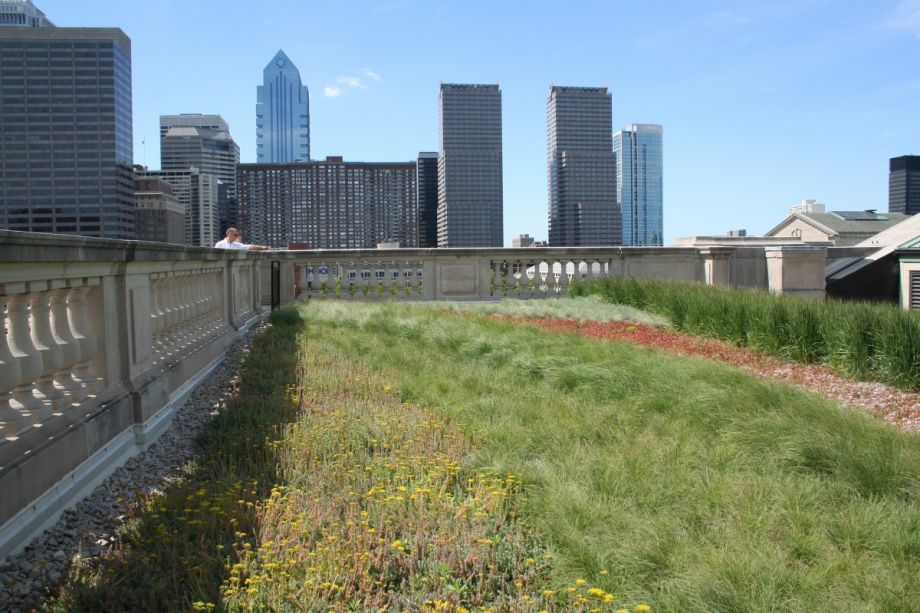Paint on a green roof here. Add a rain garden there. Water-saving techniques have been around for years, but it can be tough to show how such building modifications can pay off for owners.
That’s why, last month, the Philadelphia Water Department released Credits Explorer, an app that invites users to add — virtually — green stormwater infrastructure to their properties. In addition to green roofs and rain gardens, users can experiment with permeable pavement, underground basins, and other tools made of plants, soil, and stone that absorb stormwater instead of letting it run off into the quickly overworked sewer system. Credits Explorer then calculates how much property owners will save on their monthly Stormwater Management Service charge, a utility fee applied to all non-residential properties in Philadelphia to recover the cost of stormwater management.
“We’re really hoping to see the Credits Explorer highlight what’s possible,” says Erin Williams, an engineer who manages the stormwater billing team at the Philadelphia Water Department (PWD). The app is part of the city’s 25-year, $2.5 billion Green City, Clean Waters plan to manage stormwater and protect watersheds. Philadelphia spends $110 million per year managing stormwater, all of which is paid for by the stormwater fee.
Property owners who install green stormwater management tools — which not only reduce runoff but often also create habitats for animals, provide a cooling effect and can be very attractive — are eligible for credits that can reduce the fee by up to 80 percent. All new construction and infill development in the city must adhere to stormwater regulations and is eligible for credits. Owners of existing commercial properties can retrofit to be eligible for savings.
Before Credits Explorer, customers would call Williams’ department to ask how many credits they would be eligible for if they installed a permeable parking lot or a subsurface water basin. “We were doing those calculations by hand,” says Williams. “Now we can direct them to a tool. We’re hoping it’s going to increase awareness and ease.”
Credits Explorer works in tandem with PWD’s newly released Stormwater Retrofit Guidance Manual, a 186-page guide for non-residential property owners who want to build green infrastructure and reduce their fee. (Only commercial, industrial or residential properties with more than four units are eligible for stormwater credits.) The fee is based upon the total area of a property compared to its impermeable area — roofs, sidewalks and other surfaces that don’t absorb rainwater. Infrastructure like rain gardens and green roofs absorb rainwater instead, so it doesn’t overwhelm the sewer system and send pollutants into nearby rivers and streams.
Until 2010, PWD calculated a property’s stormwater fee based on the size of the property’s water meter. But of the city’s 90,000 non-residential properties, nearly half had no active water account and hence weren’t getting billed the stormwater fee. Vacant properties or structures like parking lots didn’t need water service but produced plenty of runoff. Skyscrapers were being charged more than strip malls because their water mains were larger, but their stormwater impact was far less.
“Customers said, you really need to make this more equitable,” Williams says. So PWD restructured its billing process to take into account the true environmental costs of impermeable surfaces. The department launched an app called Parcel Viewer, which allowed users to see the impermeable area and stormwater fee for a property. But it didn’t allow them to visualize changes.
Credits Explorer encourages users to innovate and experiment. Replace half the parking lot with a sunken rain garden, filled with plants resistant to both flood and drought? Or keep the lot and construct subsurface water storage beneath it? The app is interactive, visual and, most importantly for Williams, an easy-to-use teaching tool. “I know what a rain garden is,” she says. “I know what a subsurface basin is, but not everyone does.” The app explains, and links users to myriad resources to learn more.

Using Credit Explorer to “add” green stormwater infrastructure to the building where Next City’s office is located in Philadelphia. The app is pretty addictive. Try it here.
Credits Explorer makes green infrastructure accessible; PWD is trying to make it affordable. The agency offers two grants to cover the cost, in part or in full, of retrofitting properties with green stormwater infrastructure. The Green Acres Retrofit Program (GARP) provides grants to contractors to undertake stormwater management projects across multiple properties. The Stormwater Management Incentives Program (SMIP) provides grants to individual property owners.
So far, at least 50 properties have benefited from the retrofit grant program, says Williams. She hopes Credits Explorer will encourage more property owners to apply for the grants, build green infrastructure and receive the credits. “That’s the number one thing for people,” says Williams. “If they can save money, especially with the grant money in play, why would you say no?”
Jen Kinney is a freelance writer and documentary photographer. Her work has also appeared in Philadelphia Magazine, High Country News online, and the Anchorage Press. She is currently a student of radio production at the Salt Institute of Documentary Studies. See her work at jakinney.com.
Follow Jen .(JavaScript must be enabled to view this email address)
















